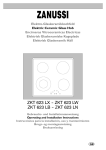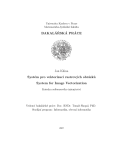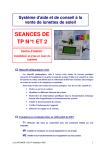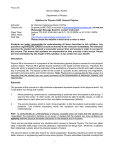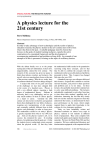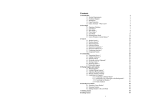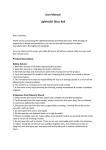Download Gamasutra - Features - "Exploring Spring Models" [10.05.01]
Transcript
Gamasutra - Features - "Exploring Spring Models" [10.05.01]
1 of 18
http://www.gamasutra.com/features/20011005/oliveira_pfv.htm
Gama Network Presents:
Exploring Spring Models
By Gustavo Oliveira
Gamasutra
October 5, 2001
URL: http://www.gamasutra.com/20011005/oliveira_01.htm
The first time I implemented a spring model, it fascinated me for hours. The effect itself is
amazingly realistic, and its implementation is fairly simple. Fortunately, I found a lot of
articles, references, and source code to help with my research. Nevertheless, as I went further
down the road, I noticed that in most cases these references limited to the standard
applications of spring models -- string, cloth and jelly.
This article reviews the implementation of a spring model from its simplest form to more
sophisticated applications, taking the subject a step beyond the material available in most
references.
Spring Basics
Before modeling springs with the computer, you need to understand the basic principles of
springs from your classic physics book.
As you compress or extend a spring, it creates a force that is opposed to direction fo the force
that you are applying. This force is mathematically equated by the formula:
F = -k*Dx
Dx = xc-xi
Where F is the resultant force, k is the spring coefficient, and Dx the distance from its inertial
position (xc = current distance, and xi = distance at the inertial position).
Mathematically, you can think of a spring as being two points separated from a distance x. This
is its inertial position. In other words, if you don't move these points, no force will be
generated because Dx = 0. If you try to compress the distance between these points the Dx
will be negative, generating a positive force (expansion). If you try to separate these points
the Dx will be positive, generating a negative force (compression). The picture below illustrates
these cases.
Pa -/\/\/\/\/\/\/\/\/\/\/\/\/\/\/\/\/\/\/\/\/\/\- Pb (Dx = 0, F = 0)
Pa -/\/\/\/\/\/\/\/\/\/\/\/\/\/\/\/\- Pb (Dx < 0, F > 0)
Pa -/\/\/\/\/\/\/\/\/\/\/\/\/\/\/\/\/\/\/\/\/\/\/\/\/\/\/\- Pb (Dx > 0, F < 0)
Springs (using "ascii art")
The k coefficient is called the elasticity coefficient, and weights the spring's final force. In other
words, a spring with bigger k is stiffer because it creates a larger force from its inertial state.
Conversely, a spring with a smaller k is more flexible because it creates a smaller force from
its inertial state.
14/10/2004 00:23
Gamasutra - Features - "Exploring Spring Models" [10.05.01]
2 of 18
http://www.gamasutra.com/features/20011005/oliveira_pfv.htm
Spring Force Implementation
Implement the spring force is a direct application of the first two equations. In other words,
first compute the distance of the spring's extremities (Pa and Pb). This is done through
Pythagoras' theorem. Once you have the distance, you subtract from the inertial distance
getting the Dx. Then, multiply this scalar value to the k coefficient and finally use the inverse
of this value to compute the force.
As simple as it sounds, the implementation in C code has its details. First, the distance Dx, and
the k coefficient are scalars, but the force itself is a vector. Therefore, it requires a direction,
which can be from Pa to Pb, or from Pb to Pb. As of right now, the code below always use the
direction Pb to Pa, or mathematically Fdir = Pb-Pa.
As the force's direction is normalized, you can use the distance you already computed for the
Dx for the normalization. You must be careful is to avoid division by zero when normalizing the
vector. This is a nasty condition and it usually does not happen, but you have to do something
about it in case it does. You have two options in this particular case: assign a random force to
the points, or null out the force. Theoretically, the force should be big enough that as the
points get closer they will never occupy the same space. Therefore, it seems to be a good
option to randomly assign a massive force in this case. However, this can cause undesirable
artifacts, because some points inside the spring model might fly a part with extreme velocity
when compared with others. Although nulling out seems wrong, it doesn't cause any major
problems and preserves the spring's stability. The code below shows the implementation; it's a
little redundant for sake of clarity. I null out the force in case of potential division by zero.
Listing 1: Computing A Spring's Force
#define SPRING_TOLERANCE
(0.0000000005f)
void SpringComputeSingleForce (VECTOR *force, VECTOR *pa, VECTOR *pb, float k,
float delta_distance)
{
VECTOR
force_dir;
float
intensity;
float
distance;
float
delta;
//get the distance
float dx =
pb->x-pa->x;
float dy =
pb->y-pa->y;
float dz =
pb->z-pa->z;
distance = (float) sqrt ((dx*dx)+(dy*dy)+(dz*dz));
if (distance
{
force->x
force->y
force->z
< SPRING_TOLERANCE)
=
=
= 0.0f;
return;
}
force_dir.x = dx;
force_dir.y = dy;
force_dir.z = dz;
//normalize
force_dir.x /= distance;
force_dir.y /= distance;
force_dir.z /= distance;
//force
delta = distance-delta_distance;
intensity = k*delta;
//store
14/10/2004 00:23
Gamasutra - Features - "Exploring Spring Models" [10.05.01]
3 of 18
http://www.gamasutra.com/features/20011005/oliveira_pfv.htm
force->x = force_dir.x*intensity;
force->y = force_dir.y*intensity;
force->z = force_dir.z*intensity;
}
Connecting Springs
Computing the spring force in one direction for a single spring doesn't do much. The power of
springs comes when you connect them into a network. Then, the computed force of one spring
affects the entire network. In other words, if one point moves, it creates a force that
propagates through the connected springs. This results into a realistic movement of connected
points simulating what would happen in real life.
The three common applications of connected springs are string, cloth, and jelly. These models
are very similar. The only difference is their initial geometric arrangement and how their
springs are connected. For instance, to model a string you connect springs as a line (one
dimension). To model cloth you connect springs as a plane (two dimensions). Finally, to model
jelly you connect springs as a volume (three dimensions).
Before implementing these applications, take a closer look of how two springs can be
connected. Figure 1 shows two springs represented by two think colored lines, with the
extremities represented by three points. The forces that can be created between these points
are shown with arrows.
Figure 1: Forces between Two
Springs
From Figure1, two connected springs can generate four forces. For example, if you move and
hold P0 the left, the force P0->P1 will be created to pull P0 back closer to P1. Also, the force
P1->P0 will be created to move P1 closer to P0. As P1 is also connected to P2, the forces
P1->P2 and P2->P1 will be also created to approximate these points. If you had more points,
the forces will keep propagating through the springs because of its connections.
You don't have to necessarily follow the arrangement of Figure 1. For example Figure 2 shows
four springs connected together in a different manner. Again, the thick colored lines represent
the springs, the points its extremities, and the arrows the forces that can be created between
them.
Figure 2: Forces between Four
Springs
14/10/2004 00:23
Gamasutra - Features - "Exploring Spring Models" [10.05.01]
4 of 18
http://www.gamasutra.com/features/20011005/oliveira_pfv.htm
In this arrangement there are four possible acting forces on P1 derived from P0, P2, P3 and
P4. Also, you don't necessarily have to connect a point to its neighbors as in the previous
figures. For instance you can add another spring connecting P0 to P2. Or even add more than
one spring connecting two points. In fact, they way you build your spring network is entirely
up to you. The arrangement you choose, however, will affect your final spring model behavior.
Based on this idea, the figures below show ways to connect springs for a string, a cloth and a
jelly respectively. In each arrangement the edges represents one spring. The blue dots are the
extremities of the springs.
Figures 3-5: String
Arrangement, Cloth
Arrangement, Jelly
Arrangement*
In each configuration, if you move one point it will realistically simulate the object's behavior.
However, this is not entirely true for the particular jelly arrangement presented. Indeed the
arrangement of Figure 5 is unstable. If you model a jelly exactly like in Figure 5, moving one of
its points will morph the jelly into a different object. Soon the original cubical shape will be be
gone. Why? Because the spring force formula requires the scalar Dx, and its direction is
irrelevant. Therefore, if you simply rotate two connected springs, they can move to another
configuration where no forces will be created. Figure 6 and Figure 7 below clarify the last
statement by showing two sets of springs that do not create any forces. In both cases the Dx
= 0, but their geometric shape are different.
14/10/2004 00:23
Gamasutra - Features - "Exploring Spring Models" [10.05.01]
5 of 18
http://www.gamasutra.com/features/20011005/oliveira_pfv.htm
Figures 6-7: Inertial Springs
(Dx = 0), Inertial Springs (Dx
= 0)
Because the springs can rotate around their extremities without creating any forces, you must
be careful when modeling and connecting your springs. This is probably the most important
part of the implementation. You must design your spring model to be able to swing nicely
without morphing it into something unrecognizable. Also, your design should use the least
number of springs for the sake of calculation time. Figure 8 composes a stable arrangement for
a jelly model. In this arrangement there are a lot more springs than the previous one, and
some vertices connect up to six springs. This is still not the only way of connecting them to
create a stable model. For example you can stack the cloth model and connect all the planes
with more springs. This configuration will be computationally more intense, and it will behave
differently than the arrangement of Figure 8. Again, the final arrangement is up to you, and it
depends on what you are trying to simulate.
Figure 8: Stable Arrangement
For Jelly
Implementing a String
With the basic information already presented, let's look in how to implement the simplest
spring model --a string. Despite of its simplicity, once you understand how to implement a
string, other models become just an extension to the same basic idea.
To begin, you need a data structure that allows you to save the spring's position, compute its
forces, and enable connection to other springs. Therefore, it is easier to design your data for
the spring's extremities instead of each spring itself. In this implementation, each extremity of
a spring is called a spring node. Two spring nodes compose one spring. As a polygonal mesh
has a list of vertices, the spring model will have a list of spring nodes. The code below shows
the basic data structure for each spring node, and the helper data structure VECTOR.
Listing 2: Spring Node Data Structure
14/10/2004 00:23
Gamasutra - Features - "Exploring Spring Models" [10.05.01]
6 of 18
http://www.gamasutra.com/features/20011005/oliveira_pfv.htm
#define SPRING_MAX_NEIGHBOR_COUNT (128)
typedef struct
{
float
float
float
}
_vector
x;
y;
z;
VECTOR;
typedef struct _spring_node
{
VECTOR
pos;
VECTOR
vel;
VECTOR
force;
SPRING_NODE*
float
int
//current position
//current velocity
//resultant
neighbor_node[SPRING_MAX_NEIGHBOR_COUNT];
neighbor_x[SPRING_MAX_NEIGHBOR_COUNT];
//distances
neighbor_count;
} SPRING_NODE;
The spring node data structure above holds the current position, velocity, resultant force and
pointers to the neighbor nodes. It also saves the distance x from the neighbor nodes at the
inertial state -- necessary to compute the resultant force. Yet, Listing 2 is a little nasty. Like
Listing 1, it was written that way simply for educational purposes. For instance, this data
structure is used for build time only. Therefore, to save some memory, it would be better to
use linked lists for the neighbor pointers and distances instead of arrays.
In a nutshell, the spring model is simply a list (array) of spring nodes. And to build a string (or
any spring model) all you have to do is to set up the spring model initial geometric
arrangement, and connect its nodes properly. Then you are ready to animate it, by computing
the internal forces and applying to the points.
Before you see the animation loop details, take a closer look into the spring model data
structure, followed by the string creation code. Listing 3 depicts the main data structures used
to build any spring model. As you see it is nothing more than a collection of nodes, and extra
fields for forces calculation, and debugging.
Listing 4 is the actual setup code for a string. It has four main parts. First, it allocates memory
for the string data and assigns the main parameters to it. Second, it positions the nodes
aligned to the xz positive axis. Third, connects the nodes and assigns the inertial distances for
the nodes and its neighbors. The last part is where the spring model behavior is defined. This
part of Listing 4 is fairly simple, and (hopefully!) easy to read. That's because it models a
string, and the implementation takes advantage of the string's symmetry. The last part of
Listing 4 is setting up the anchor point. This is a point that will not animate no matter how
strong the forces are on it. The anchor points are used for the debugging and testing. To drag
model around, you need at least point. In some models, as you will see later, the anchor
points are useful to keep the spring model stable.
Listing 3: Spring Model Data Structure
#define
#define
SPRING_MAX_NODE_COUNT
SPRING_MAX_ANCHOR_NODE_COUNT
(4096)
(256)
typedef struct _spring_anchor
{
VECTOR
pos;
SPRING_NODE*
node;
}
SPRING_ANCHOR;
typedef struct _spring
{
SPRING_NODE
node[SPRING_MAX_NODE_COUNT];
int
node_count;
//array of spring nodes
14/10/2004 00:23
Gamasutra - Features - "Exploring Spring Models" [10.05.01]
7 of 18
http://www.gamasutra.com/features/20011005/oliveira_pfv.htm
SPRING_ANCHOR
int
anchor[SPRING_MAX_ANCHOR_NODE_COUNT]; //stability & debug
anchor_count;
float
float
float
k_coef;
energy_loss;
mass;
} SPRING;
Listing 4: Creating a String
SPRING* SpringCreateString (float distance, int num_nodes, float k_coef, float
energy_loss, float mass)
{
SPRING* spring;
if ((distance < 0.005f) || (num_nodes < 3))
{
return (NULL);
}
/////////////////////////////////////////////////////////////
//allocate memory & setup parameters
/////////////////////////////////////////////////////////////
int
mem_size;
mem_size = sizeof (SPRING);
spring = (SPRING*)MemoryAllocAndClear (mem_size);
memory
if (!spring)
{
return (NULL);
}
//adjust pointers
spring->k_coef
spring->energy_loss
spring->mass
//allocate & zero out
= k_coef;
= energy_loss;
= mass;
//////////////////////////////////////////////////////////////////////
//setup nodes position aligned with the xz+ axis
//////////////////////////////////////////////////////////////////////
SPRING_NODE* node_curr;
int tmp0;
VECTOR pos_curr = {0.0f, 0.0f, 0.0f, 0.0f};
for (tmp0=0; tmp0<num_nodes; tmp0++)
{
node_curr = &spring->node[tmp0];
node_curr->pos = pos_curr;
pos_curr.x += distance;
}
///////////////////////////////////////////////////////////////////////
//connect nodes and setup the inertial x distances
///////////////////////////////////////////////////////////////////////
//far left node
node_curr = &spring->node[0];
node_curr->neighbor_node[0] = &spring->node[1];
node_curr->neighbor_x[0] = distance;
node_curr->neighbor_count++;
//far right node
node_curr = &spring->node[num_nodes-1];
node_curr->neighbor_node[0] = &spring->node[num_nodes-2];
node_curr->neighbor_x[0] = distance;
14/10/2004 00:23
Gamasutra - Features - "Exploring Spring Models" [10.05.01]
8 of 18
http://www.gamasutra.com/features/20011005/oliveira_pfv.htm
node_curr->neighbor_count++;
//inner nodes
for (tmp0=1; tmp0<num_nodes-1; tmp0++)
{
node_curr = &spring->node[tmp0];
//connect to the previous
node_curr->neighbor_node[0] = &spring->node[tmp0-1];
node_curr->neighbor_x[0] = distance;
//connect to the next
node_curr->neighbor_node[1] = &spring->node[tmp0+1];
node_curr->neighbor_x[1] = distance;
node_curr->neighbor_count += 2;
}
////////////////////////////////
// setup anchor node
////////////////////////////////
//far right node is the only anchor
spring->anchor[0].node = &spring->node[0];
spring->anchor[0].pos = spring->node[0].pos;
return (spring);
}
Once the geometry is ready and the nodes are connected, the next step is to implement the
animation loop. Listing 5 illustrates the generic loop. Again, this code is redundant, and not
optimized, for sake of clarity. The basic idea is to loop through all the nodes, compute all the
forces on each node, and store the resultant force. Then, the resultant is used to add velocity
to the node's position. Finally, the anchor points are "fixed" by not letting the forces act on
them.
Listing 5: Animation Loop
void SpringComputeForces (SPRING* spring)
{
SpringAccumulateForces (spring);
SpringApplyForces (spring);
SpringAnchorCheck (spring);
}
To compute the final resultant force on each node, the neighbor nodes come into play. In
Listing 6 for each node you compute the forces that all neighbor nodes apply to it. Then, you
accumulate (add) all these forces and store it in the data structure. Do you remember in
Listing 1 when only one direction was necessary to compute the force? This is because as you
are looping through all nodes, and looping through all its neighbors as well. Therefore, at the
end you will be computing both directions of the same force. In other words, when P0 is the
current node, the force P1->P0 is computed. Then, when the current node is P1, the force
P0->P1 is computed. As you are computing the same force (with opposite signs) twice, this
can be optimized later. As of right now, to keep the loop easier to read, the code does it the
slow way.
Listing 6: Accumulating the Forces on Each Spring Node
void SpringAccumulateForces (SPRING* spring)
{
int
tmp1;
int
tmp0;
VECTOR
force_tmp;
SPRING_NODE* node_curr;
VECTOR*
source;
VECTOR*
dest;
float
distance;
14/10/2004 00:23
Gamasutra - Features - "Exploring Spring Models" [10.05.01]
9 of 18
VECTOR
http://www.gamasutra.com/features/20011005/oliveira_pfv.htm
resultant;
//accumulate all forces
for (tmp1=0; tmp1<spring->node_count; tmp1++)
{
node_curr = &spring->node[tmp1];
//null out resultant
resultant.x =
resultant.y =
resultant.z = 0.0f;
source = &node_curr->pos;
for (tmp0=0; tmp0<node_curr->neighbor_count; tmp0++)
{
dest = &node_curr->neighbor_node[tmp0]->pos;
distance = node_curr->neighbor_x[tmp0];
SpringComputeSingleForce (&force_tmp,
source,
dest,
spring->k_coef,
distance);
VectorAdd (&resultant, &resultant, &force_tmp);
}
node_curr->force = resultant;
}
}
To finally animate the spring model you simply apply the resultant force of each to node to
itself, making them to move. From your physics book, force and acceleration are related as
following.
F = M*Acc
Acc = F/M
As the first equation shows, to compute the node's acceleration you divide the resultant force
by the spring's mass. If the force is not null, there will be an acceleration value that is used to
increase the velocity of the node. Finally the velocity will change the node's position each
frame. Listing 7 shows the implementation of all that.
There are few important observations about Listing 7. To begin, if you remove the spring's
mass value from the code it will not make much of a difference. Although to do the extra
divide is mathematically correct, but if you simply assign the force to the acceleration value
you will get fine results. This is equivalent of having set the mass of all springs equals to one.
In the code you see the line with the extra division commented out.
Another important observation is that the code adds gravity to the final resultant force -implemented by the global variable "gSpringGravity." This is simply an additional global force
that affects all nodes making the string fall. You can take this out, or even add more of these
global forces for different results.
The last important observation is in regard to the calculation of the node's velocity. The
acceleration value adds velocity to the node, but you need to dampen this velocity somehow
each frame. If you don't, your spring model will swing forever. The "energy_loss" at the end of
Listing 7 is used to dump the node's current velocity. It is interesting to play around with the
"energy_loss" variable. For example, if you set it to 1.0, you will get perpetual motion. If you
set this variable slightly above 1.0, on every frame the system will gain energy. Eventually
your spring model will be completely chaotic and unrecognizable. Realistic values would be
between 0.0 (0 percent) to 1.0 (100 percent), but non inclusive. This will simulate real life
energy loss of moving systems due to attrition, heat and/or noise.
When I first saw my string swinging beautifully on my screen, I had not included my
14/10/2004 00:23
Gamasutra - Features - "Exploring Spring Models" [10.05.01]
10 of 18
http://www.gamasutra.com/features/20011005/oliveira_pfv.htm
"energy_loss" variable to the code. For a second I truly thought I had invented a way to create
perpetual motion. However, I had forgotten that my computer was plugged to the outlet.
Therefore, keeping my pixels moving forever would cost me infinite energy!
Listing 7: Applying Forces To The Nodes
void SpringApplyForces (SPRING* spring)
{
int
SPRING_NODE*
VECTOR
tmp0;
node_curr;
acc;
//apply resultant forces to increase vel of each spring
for (tmp0=0; tmp0<spring->node_count; tmp0++)
{
node_curr = &spring->node[tmp0];
//mass is in somehow unecessary
//acc.x
=
(node_curr->force.x+gSpringGravity.x)/spring->mass;
acc.x
= (node_curr->force.x+gSpringGravity.x);
//acc.y
=
(node_curr->force.y+gSpringGravity.y)/spring->mass;
acc.y
= (node_curr->force.y+gSpringGravity.y);
//acc.z
=
(node_curr->force.z+gSpringGravity.z)/spring->mass;
acc.z
= (node_curr->force.z+gSpringGravity.z);
node_curr->vel.x += acc.x;
node_curr->vel.y += acc.y;
node_curr->vel.z += acc.z;
node_curr->pos.x += node_curr->vel.x;
node_curr->pos.y += node_curr->vel.y;
node_curr->pos.z += node_curr->vel.z;
//energy loss for velocity
node_curr->vel.x *= spring->energy_loss;
node_curr->vel.y *= spring->energy_loss;
node_curr->vel.z *= spring->energy_loss;
}
}
Once the string starts to swing, the last part of the code just checks to see if the anchor point
has moved from its initial position. If is has, the code forces it back to the original location. In
the case of the string, the anchor point was set be one the strings extremities. This works like
you had nailed the string's extremity to a wall; one end will never move. If you hook up the
keyboard or mouse to the anchor point position you can move the string around to see how it
behaves. Listing 8 illustrates this simple check.
Listing 8: Checking Anchor Points
void SpringAnchorCheck (SPRING* springm)
{
int
tmp0;
SPRING_NODE*
node_curr;
//test new position against the anchor
for (tmp0=0; tmp0<spring->anchor_count; tmp0++)
{
node_curr = spring->anchor[tmp0].node;
14/10/2004 00:23
Gamasutra - Features - "Exploring Spring Models" [10.05.01]
11 of 18
http://www.gamasutra.com/features/20011005/oliveira_pfv.htm
if (node_curr->pos.x != spring->anchor[tmp0].pos.x)
{
node_curr->pos.x = spring->anchor[tmp0].pos.x;
}
if (node_curr->pos.y != spring->anchor[tmp0].pos.y)
{
node_curr->pos.y = spring->anchor[tmp0].pos.y;
}
if (node_curr->pos.z != spring->anchor[tmp0].pos.z)
{
node_curr->pos.z = spring->anchor[tmp0].pos.z;
}
}
}
Lastly, to draw the string simply hook up a render function that draws lines using the current
position of the string nodes. Listing 9 shows the render function that does that, and also draws
small crosses at each node for reference. Figures 9, 10 and 11 and 12 shows screen shots of
the string movement with some gravity value.
Listing 9: Rendering The String
RESULT SpringRenderString (SPRING* spring)
{
if (!spring)
{
return (SPRING_ERROR_PARAM_IS_NULL);
}
SPRING_NODE* node_a;
SPRING_NODE* node_b;
int tmp0;
RGBA rgba;
for (tmp0=0; tmp0<spring->node_count-1; tmp0++)
{
node_a = &spring->node[tmp0];
node_b = &spring->node[tmp0+1];
SET_RGBA (&rgba, 0x80, 0x40, 0xa0, 0xff);
LineRender (&node_a->pos,
&node_b->pos,
&rgba);
SET_RGBA (&rgba, 0xf0, 0xf0, 0xf0, 0x00);
//draw little crosses
LineRenderCross (&node_a->pos, 1.0f, &rgba);
}
LineRenderCross (&node_b->pos, 1.0f, &rgba);
return (SPRING_OK);
}
14/10/2004 00:23
Gamasutra - Features - "Exploring Spring Models" [10.05.01]
12 of 18
http://www.gamasutra.com/features/20011005/oliveira_pfv.htm
Figures 9-12: Animation of the
string.
Implementing Cloth and Jelly
14/10/2004 00:23
Gamasutra - Features - "Exploring Spring Models" [10.05.01]
13 of 18
http://www.gamasutra.com/features/20011005/oliveira_pfv.htm
If you understood the basic idea of the string's algorithm, implementing cloth and jelly is
literally the exact same thing. You can simply use the same code you have written to simulate
a string for more complex objects. The only part you need to change is the creation function
(Listing 4). Then you will have to arrange the position of the nodes and the links to its
neighbors to fit the cloth and jelly shapes.
As you may have notice, Listing 4 was fairly simple because a string is a simple object to
setup. The cloth is not too bad to setup because it is also a very symmetric object. Yet,
compared to the string, the code will be a lot more complicated. For the cloth you are going to
have to setup the nodes position's as a square shape. Then, when connecting the nodes, you
need to be careful with the corners, left, right, top and bottom edges and the inner parts of the
cloth.
And how about the jelly? It is possible, algorithmically, to setup the jelly like a stack of cloth.
Yet, the same setup code is now even more complicated than the cloth's code. First, you need
to setup the node's initial position as a cubic shape. Then, when connecting the nodes you
need to be careful with the corners, front, back, left, right, top and bottom planes and the
inner parts of the jelly. As you can see, in this case you may have to spend a lot more time on
the jelly's creation code than the physics itself. To make matters worse, if you try to model
algorithmically a jelly like the one in Figure 8, the code is going to get even more tangled up.
In this particular case, you are better offer to get a graphic paper, and write out the vertices
positions and links and setup the node's array one by one!
Fortunately, there is a better ways to setup the cloth, jelly and more complex spring models.
The main idea is to modify the creation's code for a more data driven procedure.
Data Driven Spring Models
To be able to setup the springs in a data driven way suggests, at first, the need of a tool.
However, you will probably have to spend a considerable amount of time and resources to
implement this tool, especially if you want to design complex 3d spring models.
Another way is to write a converter. It turns out that by simply converting geometry data from
a modeler tool (3D Max, Maya, Houdini, Softimage, etc.) to spring data, you can still get good
results.
The converter can save you a lot of time, and has few advantages. First, you are not limited to
symmetric geometry. In other words, the spring model is now only limited by your
imagination. Second, you can get the texture information for your spring model for free (more
about this later). Third, as a videogame programmer, you probably already have the geometry
importer code available. Therefore, all you have to do is to modify it to create springs. Fourth,
you do not have to worry about any fast algorithm during the conversion process. Once you
build your spring configuration, simply save out the spring model. Then, just reload it later on
the game.
The converter can be implemented by simply considering each vertex of the geometry vertex
list a spring node. Then, each edge connecting two vertices becomes a spring. The basic
algorithm is shown next.
for all vertices
get current vertex
for all faces
seek neighbor vertices to the current vertex
save the neighbor vertex and the "x" distance to them
loop faces
loop vertices
Although writing a converter offers several advantages, it does have a big disadvantage. Your
spring model now is hooked to the geometry data, and this is not necessarily a good way to
setup your springs. Most of 3D tools export geometry as a list of triangles. Therefore, your
springs will always have its inner cells connected as triangles. Figure 12 depicts the jelly model
arrangement converted from geometry data.
14/10/2004 00:23
Gamasutra - Features - "Exploring Spring Models" [10.05.01]
14 of 18
http://www.gamasutra.com/features/20011005/oliveira_pfv.htm
Figure 12: Converted Jelly
Arrangement
When perturbing and applying the spring forces to this jelly arrangement, it will morph into
something unrecognizable. In other words, this arrangement is unstable. Now, if writing a tool
is too much work, but converted geometry data does not work, what can you do? In a nutshell,
you can do the gross arrangement of the spring model through the converter, and manually
add or remove springs to fine tune your model. If you compare Figure 12 with Figure 8 you will
realize that they are similar. The only difference is few inner springs connecting the bottom
and top parts of the jelly.
To fine tune your springs you can write a simple tool that let you attach or delete springs from
your current spring model. This tool is far less complicated than writing a spring modeler from
scratch. Figure 13 shows the tool used to convert and edit the springs of the jelly in Figure 12
to the one in Figure 8.
Figure 13: Conversion And Editing Spring Tool
The conversion tool in figure 13 is simple mesh viewer with few extra buttons for spring
editing. The interface allows the user loop through the spring nodes, add or delete springs, add
anchor nodes, test the model, and tune the physics' parameters. Despite this tool interface's
simplicity, it allows the user to convert, tune and test the spring model in a data driven way.
Texturing and Lighting Spring Models
So far all you have seen in this article are wireframe examples, but to texture them is trivial.
When converting the geometry data to a spring model, the texture information comes with no
effort. Simply move it from your original mesh data to the spring data structure. Also, you
need to move the face data structure. In other words, to draw each triangle you need to know
which nodes compose each face. Listing 10 illustrates the basic modifications to the main data
structure to include texture information.
14/10/2004 00:23
Gamasutra - Features - "Exploring Spring Models" [10.05.01]
15 of 18
http://www.gamasutra.com/features/20011005/oliveira_pfv.htm
Listing 10: Spring Model Data Structure With Texture Information
typedef struct _spring_face
{
int
i0;
int
i1;
int
i2;
//vertex index
int
int
int
}
t0;
t1;
t2;
//texture index
SPRING_FACE;
typedef struct _spring_tvert
{
float
u;
float
v;
}
SPRING_TVERT;
typedef struct _spring
{
SPRINGM_TVERT;
SPRING_NODE
node[SPRING_MAX_NODE_COUNT]; //array of spring nodes
int
node_count;
}
SPRING_ANCHOR
debug
int
anchor[SPRING_MAX_ANCHOR_NODE_COUNT]; //stability &
SPRING_FACE*
int
face_list;
//array of face indices
face_list_count;
SPRING_TVERT*
int
tvert_list;
//array of texture coordinates
tvert_list_count;
float
float
float
k_coef;
energy_loss;
mass;
anchor_count;
SPRING;
Figures 14, 15, 16 and 17 show a textured cloth model and four animation frames. The cloth
was build by the conversion tool. Note that the red edges were deleted springs, since the
original geometry does not create a good spring structure for a cloth. Four anchor points were
set in a shape of a square around the center of the cloth.
14/10/2004 00:23
Gamasutra - Features - "Exploring Spring Models" [10.05.01]
16 of 18
http://www.gamasutra.com/features/20011005/oliveira_pfv.htm
Figures 14-17: Textured Cloth
Dynamic lighting is more complicated since your spring model is constantly morphing. In this
case you must compute the vertex normals on the fly for each frame, and there is no way
around it. The standard way is to setup pointers to neighbor faces in build time. Then, in real
time, compute and average the neighbor face normals to get each vertex normal.
Complex Spring Models
With a data driven spring system, you can pretty much model and design anything you want to
swing. You can build balloons, trees, tires, water, hair, tents, and so on. Even the standard
applications can be enhanced, like a flag with a flexible pole for example.
Another interesting effect is to mix strings with cloth or jelly like objects. You can create a cool
balloon by connecting a string to a spherical jelly. Another example would be, for a F1 game,
modeling the finish line cloth with a cloth connected by strings to the poles. As the cars cross
the line, apply the forces due to the air movement to the spring model.
Figure 18 shows the screen shot of this article's executable. There you will find few spring
models. It has a string, a cloth, a jelly, and a balloon. Except for the string, they were modeled
with the conversion tool.
14/10/2004 00:23
Gamasutra - Features - "Exploring Spring Models" [10.05.01]
17 of 18
http://www.gamasutra.com/features/20011005/oliveira_pfv.htm
Figure 18: Sample Program Screenshot
Optimizations
Spring models rely heavily on square roots, since the distance between two points is computed
several times for each frame. Luckily, newer computers can handle these computations very
easily for simple spring models. Also, the new consoles on the market have sets of assembler
instructions to perform square roots and normalizations in single instructions by hardware. For
instance, if you are a Playstation 2 developer, Listing 1 can be easily optimized using VU0
instructions.
At a higher level, the way this article's code computes the forces is redundant. If you look
carefully at the code, you are always computing the same force in two opposite directions.
Therefore, it makes sense to compute the force in one direction and simply negate it to get its
opposite. By doing this way you are potentially cutting the inner calculations is almost half.
Sample Program
The sample program demonstrates the standard applications (string, cloth and jelly) and a
more complex object (balloon). Play around with these models and see the spring's behavior in
each object. Use the interface buttons or keys I, J, K, M, Y and U move the objects. Also, the
mouse (press left or right button), arrows, key A and key Z, move the camera.
The source code for the sample program is not available. Only the string implementation is
available but with no render functions and no optimizations. The sample code is just to guide
you on your implementation.
Final Comments
The more you play with springs the more ideas you have for things you can model with them.
Objects modeled with springs can add more realism to your game. Yet, there are not many
games out exploring this neat effect.
14/10/2004 00:23
Gamasutra - Features - "Exploring Spring Models" [10.05.01]
18 of 18
http://www.gamasutra.com/features/20011005/oliveira_pfv.htm
Next time you would like to write an interesting effect for your game, see if springs can give
you new ideas. Like the famous Duke Ellington's standard says, "It Don't Mean a Thing If It
Ain't Got That Swing."
References
[1] http://freespace.virgin.net/hugo.elias/
[2] Serway. Physics For Scientists and Enginneers, Fourth Edition, pg 364-370
[3] Watt, Alan, and Fabio Policarpo. The Computer Image, Addison-Wesley, 1997.
[4] Harris, John W., and Horst Stocker. Handbook of Mathematics and Computational Science,
Springer Verlag, 1998
[5] Donald Hearn M. Pauline Baker. Computer Graphics, C Version, 2nd ed.
[6] Direct X 8 SDK Help. Microsoft Corporation
[7] Playstation 2 VU User's Manual, 2nd Edition. Sony Computer Entertainment Inc.
________________________________________________________
Editing
Copyright © 2003 CMP Media Inc. All rights reserved.
14/10/2004 00:23



















